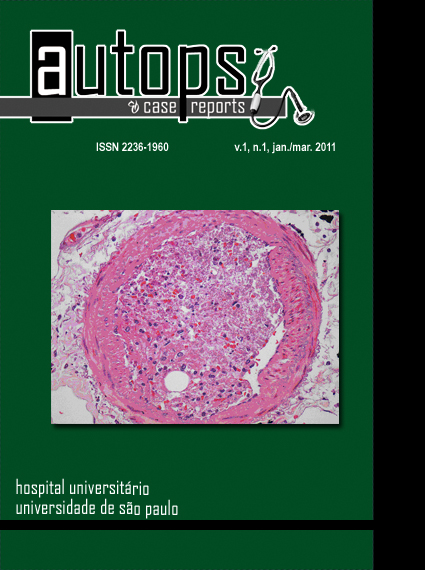Acardiac fetus: a challenge to pathologists, obstetricians and neonatologists
DOI:
https://doi.org/10.4322/acr.2016.012Keywords:
Fetal heart/abnormalities, Fetus/abnormalities, Disease in twins/physiopathology, Heart defects congenital/pathology, Fetofetal transfusion/complications.Abstract
Acardius is one of the most severe human malformations, a rare complication present only in monozygotic and monochorionic multiple pregnancies. In this disorder, the major defect is the lack of well-defined cardiac structure in acardiacfetus, whose irrigation is maintained through placental vascular anastomoses with the normal fetus, called fetal donor, thereby establishing a reverse arterial perfusion in the umbilical cord of the acardiac twin (TRAP sequence). The poor circulation leads to a state of hypoxia in the early stages of fetal development,
causing structural abnormalities, with different phenotypes, which are classified as: Acardius acephalus, anceps, and acormus amorphus. We relate a case of an acardiac anceps fetus that interestingly was reported by the physicians to present spasmodic movements just after the delivery. Due to severe malformations observed in an acardiac twin by the time of delivery, it is likely that many cases go unnoticed or misdiagnosed. The pathological findings are briefly reviewed
to provide an adequate post mortem diagnosis of acardiac fetus and placental examination.
Downloads
Download data is not yet available.
Downloads
Published
2011-03-08
Issue
Section
Article / Autopsy Case Report
License
Copyright
Authors of articles published by Autopsy and Case Report retain the copyright of their work without restrictions, licensing it under the Creative Commons Attribution License - CC-BY, which allows articles to be re-used and re-distributed without restriction, as long as the original work is correctly cited.
How to Cite
Ferreira, C. R., Simões, A. B., Zerbini, M. C. N., & Quintal, V. S. (2011). Acardiac fetus: a challenge to pathologists, obstetricians and neonatologists. Autopsy and Case Reports, 1(1). https://doi.org/10.4322/acr.2016.012



